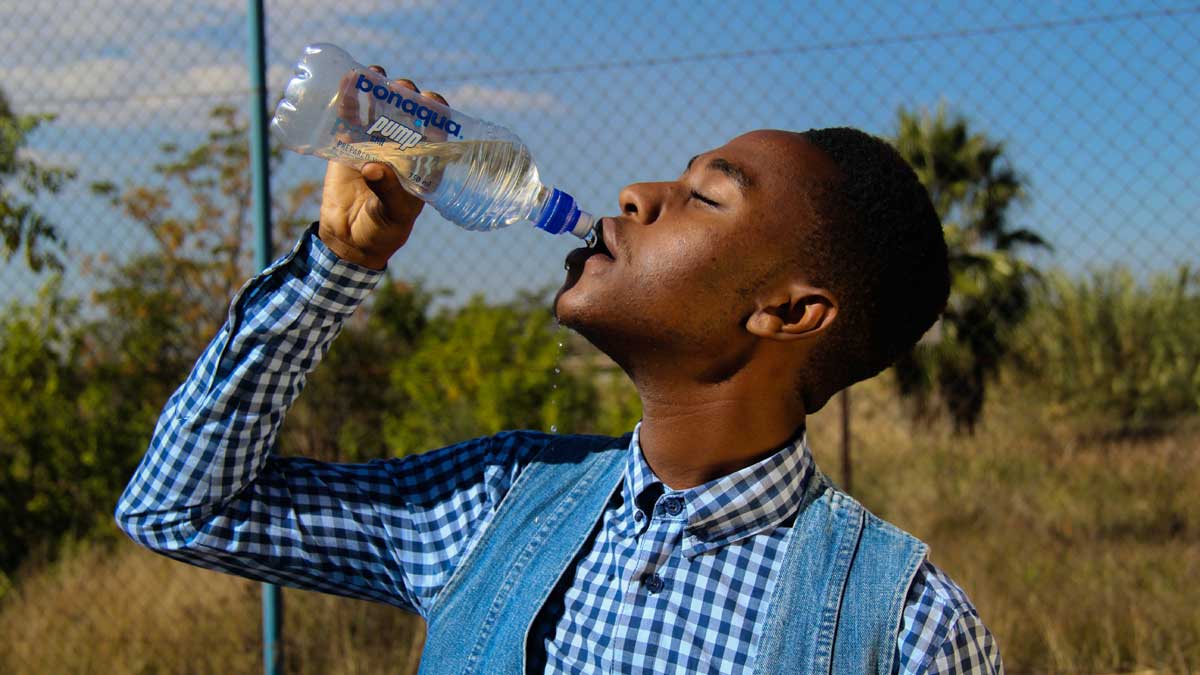The sun is something we can’t escape. At 4.5 billion years of age and it is estimated to have another 5-6 billion years before it runs out of hydrogen and engulfs Mercury, Venus, and Earth.
The sun radiates heat and light, also known as solar energy, which is needed to sustain life on Earth. Our bodies use the UVB rays from the sun for vitamin D formation, with the best times for us to get that benefit being between 10:00 AM and 2:00 PM. Solar noon, which occurs at 1:00 PM, is the peak for obtaining these rays.
Not only do humans need the sun to survive, but so do other animals, and even the plants around us. All plants require light from the sun for photosynthesis, the process within a plant that converts light, oxygen, and water into carbohydrates (energy), in order for plants to produce seed, grow, and bloom.
Without the sun to heat the Earth, it would freeze. Although some microorganisms living in the Earth’s crust could survive, the majority of life on our planet would enjoy only a brief post-sun existence, eventually dying.

The Powerful Sun Facts
- The sun is the closest thing in nature to a perfect sphere.
- It is 93 million miles from the earth.
- It takes 8 minutes and 19 seconds for light from sun to reach us on earth.
- It has 6 layers and its outermost layer has a temp of 9,941 degrees fahrenheit.
- The sun’s core temperature is 27 million degrees fahrenheit — which is beyond hot.
- It has a 423,000 mile radIUs (for comparison, the Earth’s radIUs is a mere tad under 4,000 miles).
- Over 1 million earths could fit inside the sun!
- The sun is a star that is closest to the earth (reason we see it so brightly).
- The sun has different forms of radiation — visible light, infrared, UA, UVB and UVC. It releases tremendous energy via nuclear fusion in the form of radiation, electricity, and solar wind. UVC rays are blocked by ozone layer and thus we have a natural shield from these powerful rays.
Vitamin D from the sun is crucial in the prevention of a variety of conditions and disease.
Disease Prevention
Vitamin D from the sun is crucial in the prevention of a variety of conditions and disease. In fact, a growing body of evidence demonstrates how Vitamin D is a cofactor in the regulation of at least 3,000 out of the 30,000 genes in the human body.
Some conditions that lack of Vitamin D can bring on include:
- Rickets
- Osteoporosis
- Depression
- Cancer
- Hypertension/Cardiovascular Disease
- Multiple Sclerosis
- Type 2 Diabetes Mellitus
- Respiratory Infections and Viruses
- Chronic Inflammation
- Insomnia and Sleep Apnea
- Age-Related Macular Degeneration/Myopia
- Alzheimer Disease
- Other conditions, like gout and spinal cord diseases
Rickets
Children who were not in sun in 1920’s developed rickets.
Osteoporosis
High quality diet, exercise, sleep, and relaxation are of very high importance in bone strength, however bone development is very dependent on Vitamin D formation from sun exposure. Adults who do not have sufficient Vitamin D (mainly from sun) cannot process calcIUm and other minerals that will lead to osteoporosis.
Depression
Depression can be instigated by lack of natural light, and sunlight helps to enhance serotonin and melatonin production, both hormones of which are mood elevating and stabilizing.
Cancer
Adequate Vitamin D can assist in cancer cell disintegration and slow down cell growth and spread. It also prevents angiogenesis, the formation of blood vessels for the cancer, and aids in Melanoma prevention.
Hypertension and Cardiovascular Disease
Studies are showing how UV light exposure allows for nitric oxide release in the skin that can help reduce blood pressure by several points.
Multiple Sclerosis
The farther away from the equator a person is, the higher the risk for MS. Vitamin D has been shown to have a relationship to how the immune system reacts with regard to the myelin sheath that covers fast-acting nerves. Studies also show those with ms have low D levels and supplementation has been promising in its benefit for this condition. Caution with excess heat exposure is warranted, however, due to the extreme fatigue that high heat can cause in MS.
Type 2 Diabetes Mellitus
Studies underway that indicate powerful correlation with sunlight deficiency and development of DM.
Respiratory Infections
In a large analysis of more than 11 thousand participants, the level of Vitamin D was very significant in that supplemental Vitamin D was associated with lower rates of respiratory infections such as Tuberculosis, Pneumonia, colds, and other respiratory viruses.
Chronic Inflammation
Significant anti-inflammation is noted in lab studies on Vitamin D in both human and lab animal cell lines. Benefits for autoimmune and other inflammatory conditions in heart, gut, and nervous systems are under study. In all these areas, Vitamin D, from sunshine especially, has shown to be beneficial.
Insomnia/Sleep Apnea
Studies show links between lack of sleep and sleep apnea. In one study of 1,500 people who had insomnia in 2012, Dr. Stasha Gominak published her results showing a replenishment of Vitamin D levels via sunlight and/or supplentation to levels of 60-80 ng/ml that alleviated insomnia. Another study published in 2014 showed a reduction in airway obstruction in sleep apnea disorders.
Age-Related Macular Degeneration/Myopia
ARMD has nothing to do with sunlight, according to studies that included 44,000 people. Interestingly, it is found that 0.9% of people of color and 2.5% of caucasians develop this condition chiefly due to lack of lutein, zeaxanthins (antioxidants found in blueberries, salmon, pistachios and eggs), Omega 3 fatty acids and excess intake of Omega-6 fatty acids. However, Myopia is also seen in children not exposed to sunlight regularly.
Alzheimer Disease
There are many studies underway indicating the need for sunlight to protect and enhance cognitive function.
Other Conditions
Other conditions that also benefit include gout, spinal cord diseases, Psoriasis and other skin diseases.

Sun Protection
While the sun and the Vitamin D it produces can be beneficial, and the threat of loss of life is greater without the sun than with, we do have to protect ourselves from it to some extent as well.
Participating in outdoor sports, including swimming, in bright sunlight, may require some protection for those who are vulnerable. And, the reapplication of sunscreens may be needed.
Conditions such as skin aging, heatstroke, sunburn, freckles, moles, and potential skin cancers must be taken into consideration. Often many individuals don’t need any special protection unless the following conditions exist:
- You have extremely fair skin
- You have sun sensitivity with Solar Urticaria, which is a rare allergic reaction to sun exposure, Rosacea, Lupus, etc.
- You suffer from Xeroderma Pigmentosa (rare congenital skin disease)
- You are taking medications that would cause sun sensitivity like antibiotics, anticonvulsants, antifungals, antihistamines, oral contraceptives
- Your skin already sunburned or has any type of burn
The best sources for protection from the sun include:
- Wearing clothing with sunblocking capacity
- Wearing thick cotton or tight natural weave wide brim hats covering head and face
- Using umbrellas and tents to shield from the sun
- Eating a plant diet and getting plenty of water and electrolytes into your body
- Using non-nano particle zinc oxide and titanIUm oxide; other ingredients acceptable are sunflower oil, calendula with coconut oil, aloe vera and shea butter
The Sun and Skin Cancer
By conventional medicine standards, skin cancers, such as basal cell, squamous cell, and melanomas are associated with repeated intense sunburn. Lesser intensity exposure is generally not a cause for skin cancer. However, of note, association does not necessarily imply causation.
From an energetic perspective, however, the cause for skin cancer is excess yin factors discharged to the surface such as milk, dairy, oily, spicy, sugary, fruits, spices, drugs, alcohol, stimulants, and protein supplements.
To put things in perspective, note these statistics:
| Death from lack of sun | 1,684,677 |
| Death from sunlight | 5,125 |
| Ratio | 329:1 |
When you consider using products to protect your skin from the sun, some products to avoid include:
- Oxybenzone, an ingredient in sunscreen linked to skin cancer formation
- Parabens, which have been linked to cancer
- Octisolate
- Octocryene
- Avobenzone
- Petroleum products
- Any reef destroying products
Optimize Your Vitamin D
Know your Vitamin D level by having your health provider order tests or send in your own blood testing kit. Optimal levels are between 60-80 ng/ml. Remeasure your levels after 4-5 months to note changes. If your sun exposure is inadequate, add an oral form of Vitamin D.
Foods naturally containing D include salmon and other fatty fish, mushrooms and eggs. All fortified products contain Vitamin D.
Sun Exposure
Each minute in the sun will provide approximately 1000 IU of Vitamin D3 via conversion of the skin uptake of solar energy and transport to the liver. Because of this, it is best to expose as much of skin as possible without sunblock for a certain amount of time. However, you do need to be sure not to exceed your exposure time so much that you cause skin burning.
If your skin is naturally strongly pigmented, i.e. the closer your heritage is to the equator (lower latitudes), you will need more time in sun for Vitamin D production and the use of an oral or injectable form is advisable due to the problem of deficiences. The melanin in skin of darker skin shades is a strong blocker of sunlight, hence a relative deficiency is more likely.
The recommended time spent in the sun, based on your skin shade, is:
- Fair Skin: 15 to 20 minutes
- Olive Skin: 25 minutes
- Darker One Shade: 30 minutes
- Darker a Second Shade: 30 to 40 minutes
- Darkest Skin: 45 to 55 minutes
You should remove yourself to a more protected area if you feel skin becoming tender to touch when getting sun exposure.
Supplementation
When maximum daily sun exposure is not possible, you should supplement with Vitamin D3 (cholecalciferol, which is better absorbed than D2, ergocalciferol). It is recommended that you get 2000 IU daily for levels 30-40 ng/ml, and 5,000 to 10,000 IU daily if you are moderate to severely deficient. A better form of vitamin is a plant or plankton-derived source.
Everyone is urged to ensure that these other nutrients are also taken into their bodies, preferably via diet:
- Vitamin K2 (menaquinone) at 90-100 mcg along with Vitamin D3
- Magnesium – 400mg daily
- Omega 3 fatty acids, good food sources of protein, fats, and minerals
Keep in mind, the older a person is in age, the less sun absorption capacity they have. It is wise for older individuals to use a good supplement that is plant based. Oral capsules or liquids are best.
The Importance of Water
We are water beings! We are a mean 60% water, and adults have about 1.2 to 1.5 gallons of blood in our bodies. Babies are 78% water, and this drops to 65% after about a year. Adults need about half of our body fluid volume replenished on a daily basis.
We should be very careful when consuming water. We should always be drinking clean, filtered water, and even hydrogenated water, and avoiding plastic and additives.
As a reminder on volume measurements:
- 1 gallon = 120 ounces or 4 quarts
- 1 quart = 32 ounces
- 1 liter = 35 ounces
- 1 cup = 8 ounces
So, if you drink 8 cups of beverages (preferably water) a day, you are taking in 64 ounces. And, if you also eat 8 cups of plant foods, such as fruits and vegetables, you are taking in close to 1 gallon of water a day.
Adult women are 55% water and need about 2.2 liters (2.3 quarts = 73 ounces) daily; which would be 9 cups from drink.
Adult men are 60% water and need about 3 liters (3.2 quarts = 102 ounces) daily; which would be 11 to 12 cups from drink.
Don’t forget that water comes from both food and drink — about 20% from food. All drinks and soups would also count. So, if you are a vegan, or have a high intake of plants, you may already be taking in a good amount of water.
1 cup of fruits or vegetables cna yield approximately 1/4 to 1/2 cup of water. For example, 1 cup of strawberries is about 4 ounces of water, 1 cup of celery has 3.5 ounces of water, and 1 cup of garbanzo beans contains about 1 ounce so water. So, if you are eating multiple servings of these types of food the amount of water consumed is additive.

How Much Water is Too Much?
When trying to calculate how much water you should consume, you must always consider factors such as:
- Physical activity
- Climate
- Sex
- Body weight
The average daily amount of water needed is above. However, certain demographics such as children, elderly individuals, athletes, and soldiers may need more water to sustain their bodies and conditions. The more active you are, the more you will need.
In general, we require add 12 ounces of water for high impact and up to 24 additional ounces for sustained muscle and CV stress.
Excess water intake would be more than 2 liters in one hour. Consuming this much can cause hyponatremia with weakness, passing out, and brain and blood changes that can be troubling. Any excess sweating may warrant up to 1.5 liters in 1 hour maximum.
Soldiers who consumed in excess of 2 to 5 liters in one hour were more seriously injured in studies examining military recruits.
The Future of Sun and Water
Science is following our sun and it will not be dulling anytime soon!
Cherish every moment with the sun.
Protect the water.
Be conscious of these wonderful and vital elements.
References and Recommended Reading
- British Medical Journal. “Vitamin D Supplementation To Prevent Acute Respiratory Infections: Systemic Review And Meta-Analysis Of Individual Participant Data.” 2017; 356
- Gao, Q. Et Al. “Effect Of Sun Exposure On Cognitive Function Among Elderly Individuals In Northeast China.” 2018, Clinical Interventional Aging, 13: Pp. 2075-2082
- Gardner, J. “Death By Water Intoxication.” Military Medicine; 2002, May; 167 (5): 432-434
- https://sunlightinstitute.org
- Kushi, M. The Macrobiotic Path To Total Health. Ballantine Book Publishing, Ny, 2003; Pp 171-174
- Liu, D. Et Al. “UV Irradiation Of Human Skin Vasodilates Arterial Vasculature And Lowers Blood Pressure.” Journal Of Investigative Dermatology; 2014, Vol 134(7): 1839-1846
- Noakes, T. “Hyponatremia In Distance Runners: Fluid And Sodium Balance During Exercise.” Current Sports Medicine Reports. 2002, August; 1(4): 197-207
- Sorenson, M. Et Al. Embrace The Sun. 2018, Marc Sorenson Publisher, USA.
- Wu, S. Et Al. “Moderate Sun Exposure Is The Complimentor In Insufficient Vitamin D Consumers.” 2022, Frontiers In Nutrition, https://Doi.Org 10.3389
source https://wellcomeomcenter.com/on-sun-and-water-just-how-much-do-we-need-of-each/
No comments:
Post a Comment